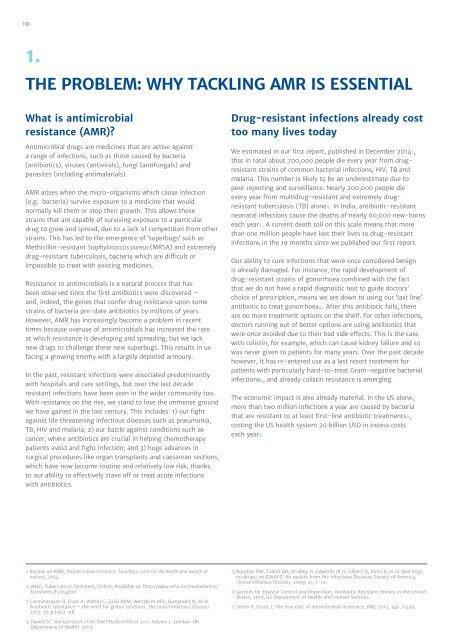TACKLING DRUG-RESISTANT INFECTIONS GLOBALLY FINAL REPORT AND RECOMMENDATIONS
qQvJ300ETXu
qQvJ300ETXu
You also want an ePaper? Increase the reach of your titles
YUMPU automatically turns print PDFs into web optimized ePapers that Google loves.
10<br />
1.<br />
THE PROBLEM: WHY <strong>TACKLING</strong> AMR IS ESSENTIAL<br />
What is antimicrobial<br />
resistance (AMR)?<br />
Antimicrobial drugs are medicines that are active against<br />
a range of infections, such as those caused by bacteria<br />
(antibiotics), viruses (antivirals), fungi (antifungals) and<br />
parasites (including antimalarials).<br />
AMR arises when the micro-organisms which cause infection<br />
(e.g. bacteria) survive exposure to a medicine that would<br />
normally kill them or stop their growth. This allows those<br />
strains that are capable of surviving exposure to a particular<br />
drug to grow and spread, due to a lack of competition from other<br />
strains. This has led to the emergence of ‘superbugs’ such as<br />
Methicillin‐resistant Staphylococcus aureus (MRSA) and extremely<br />
drug‐resistant tuberculosis, bacteria which are difficult or<br />
impossible to treat with existing medicines.<br />
Resistance to antimicrobials is a natural process that has<br />
been observed since the first antibiotics were discovered –<br />
and, indeed, the genes that confer drug resistance upon some<br />
strains of bacteria pre-date antibiotics by millions of years.<br />
However, AMR has increasingly become a problem in recent<br />
times because overuse of antimicrobials has increased the rate<br />
at which resistance is developing and spreading, but we lack<br />
new drugs to challenge these new superbugs. This results in us<br />
facing a growing enemy with a largely depleted armoury.<br />
In the past, resistant infections were associated predominantly<br />
with hospitals and care settings, but over the last decade<br />
resistant infections have been seen in the wider community too.<br />
With resistance on the rise, we stand to lose the immense ground<br />
we have gained in the last century. This includes: 1) our fight<br />
against life threatening infectious diseases such as pneumonia,<br />
TB, HIV and malaria; 2) our battle against conditions such as<br />
cancer, where antibiotics are crucial in helping chemotherapy<br />
patients avoid and fight infection; and 3) huge advances in<br />
surgical procedures like organ transplants and caesarean sections,<br />
which have now become routine and relatively low risk, thanks<br />
to our ability to effectively stave off or treat acute infections<br />
with antibiotics.<br />
Drug-resistant infections already cost<br />
too many lives today<br />
We estimated in our first report, published in December 20141,<br />
that in total about 700,000 people die every year from drugresistant<br />
strains of common bacterial infections, HIV, TB and<br />
malaria. This number is likely to be an underestimate due to<br />
poor reporting and surveillance. Nearly 200,000 people die<br />
every year from multidrug-resistant and extremely drugresistant<br />
tuberculosis (TB) alone2. In India, antibiotic-resistant<br />
neonatal infections cause the deaths of nearly 60,000 new-borns<br />
each year3. A current death toll on this scale means that more<br />
than one million people have lost their lives to drug-resistant<br />
infections in the 19 months since we published our first report.<br />
Our ability to cure infections that were once considered benign<br />
is already damaged. For instance, the rapid development of<br />
drug-resistant strains of gonorrhoea combined with the fact<br />
that we do not have a rapid diagnostic test to guide doctors’<br />
choice of prescription, means we are down to using our ‘last line’<br />
antibiotic to treat gonorrhoea4. After this antibiotic fails, there<br />
are no more treatment options on the shelf. For other infections,<br />
doctors running out of better options are using antibiotics that<br />
were once avoided due to their bad side effects. This is the case<br />
with colistin, for example, which can cause kidney failure and so<br />
was never given to patients for many years. Over the past decade<br />
however, it has re-entered use as a last resort treatment for<br />
patients with particularly hard-to-treat Gram-negative bacterial<br />
infections5, and already colistin resistance is emerging.<br />
The economic impact is also already material. In the US alone,<br />
more than two million infections a year are caused by bacteria<br />
that are resistant to at least first-line antibiotic treatments6,<br />
costing the US health system 20 billion USD in excess costs<br />
each year7.<br />
1 Review on AMR, Antimicrobial resistance: Tackling a crisis for the health and wealth of<br />
nations, 2014.<br />
2 WHO, Tuberculosis Factsheet, Online, Available at: http://www.who.int/mediacentre/<br />
factsheets/fs104/en/<br />
3 Laxminarayan R, Duse A, Wattal C, Zaidi AKM, Wertheim HFL, Sumpradit N, et al.<br />
Antibiotic resistance – the need for global solutions, The Lancet Infectious Diseases<br />
2013; 13: p.1057-98.<br />
5 Boucher HW, Talbot GH, Bradley JS, Edwards JR Jr, Gilbert D, Rice LB, et al. Bad bugs,<br />
no drugs: no ESKAPE! An update from the Infectious Diseases Society of America,<br />
Clinical Infectious Diseases, 2009; 41, 1-12.<br />
6 Centres for Disease Control and Prevention, Antibiotic Resistant threats in the United<br />
States, 2013, US Department of Health and Human Services.<br />
7 Smith R, Coast J, The true cost of antimicrobial resistance, BMJ, 2013, 346, f1493.<br />
4 Davies SC. Annual report of the Chief Medical Officer 2011: Volume 2. London: UK<br />
Department of Health. 2013.


